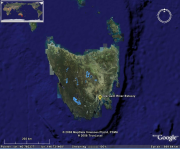Biosphere | Ecological Dynamics | Predation
Type of resources
Topics
Keywords
Contact for the resource
Provided by
Years
-
Underwater visual census surveys were conducted at 15 sites in eastern Tasmania to quantify the abundance of the sea urchin Heliocidaris erythrogramma and several putative predators.
-
Predation mortality rates of blacklip abalone (Haliotis rubra) were estimated under several different conditions using a range of manipulative experiments. Abalone mortality rates were estimated from tethering experiments inside the Maria Island Marine Reserve (MIMR) and at an adjacent site where predators, including southern rocks lobster (Jasus edwardsii) were in low abundance, due to fishing. Estimates of abalone mortality directly attributed to rock lobsters were gained from manipulative experiments inside the MIMR and in an aquarium experiment at the Tasmanian Aquaculture and Fisheries Institute facility at the Marine Research Laboratories.
-
Samples of Octopus maorum and O. pallidus have been collected from the Eaglehawk fishery and as bycatch from southern rock lobster fishery to determine population structure and spatial and temporal trends. Tag recapture study of O. maorum and O. pallidus in Taroona reserve using PIT tags and movement study using acoustic tracking at Taroona reserve and Eaglehawk neck examine the temporal and spatial scales of movement and habitat use. Octopus tracked using VR2's (presence/absence data) and VRAP (triangulated positional data) at both sites.
-

This study reports on previously undescribed predation on Asterias amurensis in the Derwent Estuary, Tasmania by the spider crab Leptomithrax gaimardii (Milne Edwards). Specifically, this study describes the predatory interaction between the spider crab and A. amurensis and quantifies patterns of sub-lethal injuries inflicted on the seastar during a localised aggregation of the spider crab.
-
Mortality rates of the sea urchin Heliocidaris erythrogramma where estimated under experimental conditions to determine the importance of natural and predation mortality in structuring sea urchin populations. Data was obtained from tethering, tagging and caging experiments at four sites within Mercury Passage and the Derwent Estuary in eastern Tasmania.
-
Estimates of blacklip abalone (Haliotis rubra) size at emergence were obtained from surveys of ten sites within the Mercury Passage on Tasmania's east coast. Size at emergence estimates were obtained from five populations inside the Maria Island Marine Reserve (MIMR) and at five adjacent sites where abalone harvesting occurs. The data sets includes abundance and size estimates of the main abalone predators, including the southern rock lobster (Jasus edwardsii), and competitors.
-
The predators of Centrostephanus rodgersii, were identified using remote video monitoring. Experiments were performed in two eastern Tasmanian regions, the Maria Island Marine Reserve (MIMR, 42° 35.26'S, 148° 3.03'E) and the Crayfish Point Research Reserve (CPRR, 42° 57.37'S, 147° 21.30'E). The impact of fishing on these predators, and ultimately on C. rodgersii, was examined by comparing survival of C. rodgersii on reefs inside no-take Marine Protected Areas (MPAs) (high predator biomass) relative to fished reefs (low predator biomass). The size-specific nature of predation interactions was examined in context of size-selective fishing pressures within the sea urchin's extended range.
 IMAS Metadata Catalogue
IMAS Metadata Catalogue